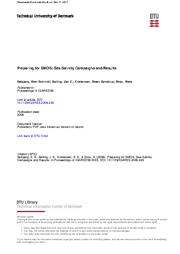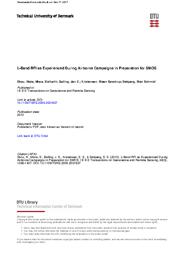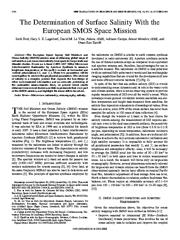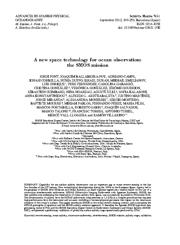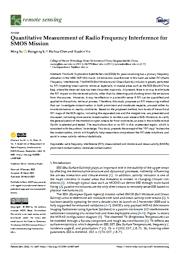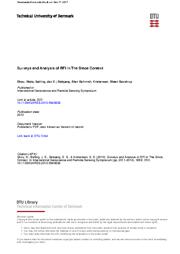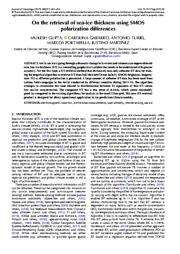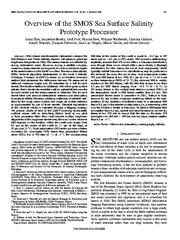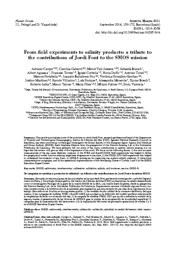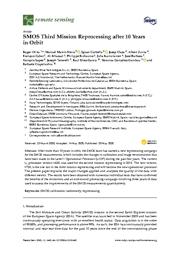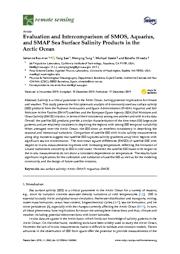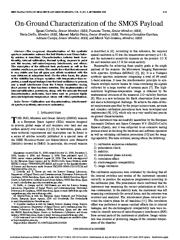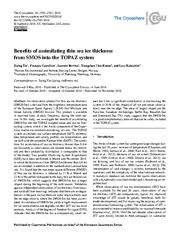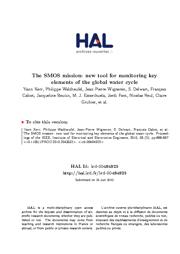A copy of this work was available on the public web and has been preserved in the Wayback Machine. The capture dates from 2019; you can also visit the original URL.
The file type is application/pdf.
Filters
Preparing for SMOS: Sea Salinity Campaigns and Results
2006
2006 IEEE International Symposium on Geoscience and Remote Sensing
Mapping of sea surface salinity, based on L-band radiometric measurements, is presently investigated as a preparation for space missions. ...
Special concern is on correction for effects caused by the sea surface roughness, and this paper will address two campaigns, LOSAC and CoSMOS, with the aim of investigating these effects. ...
INTRODUCTION Sea surface salinity, SSS, remote sensing, especially by Lband radiometry, is presently an important issue as both ESA and NASA are preparing satellite missions for that purpose. ...
doi:10.1109/igarss.2006.438
dblp:conf/igarss/SbjrgBKS06
fatcat:w6cz5hegvzepzltre7cjq4cjzm
L-Band RFI as Experienced During Airborne Campaigns in Preparation for SMOS
2010
IEEE Transactions on Geoscience and Remote Sensing
In support of the European Space Agency Soil Moisture and Ocean Salinity (SMOS) mission, a number of soil moisture and sea salinity campaigns, including airborne L-band radiometer measurements, have been ...
Campaigns were carried out in Australia and in a variety of European locations, resulting in the largest and most comprehensive data set available for assessing RFI at L-band. ...
Tauriainen as an extremely dedicated pilot; the SMOS Science Advisory Group for the fruitful discussion; and ESA staff C. Bouzinac and P. Wursteisen for organizing the airborne campaigns. ...
doi:10.1109/tgrs.2009.2031637
fatcat:ch7yiyfxnbar7enwqs3aniwute
The determination of surface salinity with the European SMOS space mission
2004
IEEE Transactions on Geoscience and Remote Sensing
The European Space Agency Soil Moisture and Ocean Salinity (SMOS) mission aims at obtaining global maps of soil moisture and sea surface salinity from space for large-scale and climatic studies. ...
Here, we present recent results obtained from several studies and field experiments that were part of the SMOS mission, and highlight the issues still to be solved. ...
and sea surface salinity from space for large-scale and climatic studies. ...
doi:10.1109/tgrs.2004.834649
fatcat:iwuzdnts6ve2neycceb6m6y4ge
A new space technology for ocean observation: the SMOS mission
2012
Scientia Marina
Capability for sea surface salinity observation was an important gap in ocean remote sensing in the last few decades of the 20 th century. ...
It describes the Spanish SMOS high-level data processing centre (CP34) and the SMOS Barcelona Expert Centre on Radiometric Calibration and Ocean Salinity (SMOS-BEC), and presents a preliminary validation ...
the SMOS mission) from the Spanish R+D National Plan, which were also the main source of funding for SMOS-BEC activities. ...
doi:10.3989/scimar.03621.19k
fatcat:d3lyelivobfcddbrdokoo5mrei
Quantitative Measurement of Radio Frequency Interference for SMOS Mission
2022
Remote Sensing
The SMOS (Soil Moisture and Ocean Salinity) mission is greatly perturbed by RFI impeding ocean salinity retrieval, especially in coastal areas such as the SCS (South China Sea), where the observed data ...
The result shows few or no RFI in this unattended region, which is consistent with the authors' knowledge. ...
We also gratefully acknowledge the SMOS team and European Space Agency, Centre Aval de Traitement des Donn Données SMOS, Barcelona Expert Center, Copernicus Marine Environment Monitoring Service for providing ...
doi:10.3390/rs14071669
fatcat:nnu5j2nzhnb53gagzv5zrw7rfq
Surveys and analysis of rfi in the smos context
2010
2010 IEEE International Geoscience and Remote Sensing Symposium
Several soil moisture and sea salinity campaigns, including airborne L-band radiometer measurements, have been carried out in preparation for the ESA Soil Moisture and Ocean Salinity (SMOS) mission. ...
Since SMOS is fully polarimetric, the 3rd and 4th Stokes parameter method is an option, and this has been used on a recent, fully polarimetric SMOS data set. ...
INTRODUCTION In November 2009, the European Space Agency (ESA) launched its SMOS satellite mission whose purpose is to measure sea-surface salinity and soil moisture by means of L-band radiometry [1] ...
doi:10.1109/igarss.2010.5649838
dblp:conf/igarss/SkouBSK10
fatcat:th5lbv2i6vdjlab3g7iodzlheu
On the retrieval of sea-ice thickness using SMOS polarization differences
2019
Journal of Glaciology
For the first time, a SIT-retrieval method that exclusively uses only airborne SIT data for training the empirical algorithm to retrieve SIT from Soil Moisture Ocean Salinity (SMOS) brightness temperature ...
ABSTRACTArctic sea ice is going through a dramatic change in its extent and volume at an unprecedented rate. ...
We gratefully acknowledge the following field campaigns for making the airborne SIT data available: SIZONet, NASA Operation IceBridge, ESA SMOSIce, TD XX and N-ICE. ...
doi:10.1017/jog.2019.26
fatcat:yxafpinlovaj3ocwkfdwdyef4e
Overview of the SMOS Sea Surface Salinity Prototype Processor
2009
IEEE Transactions on Geoscience and Remote Sensing
The sea surface salinity (SSS) retrieval algorithm implemented in the Level 2 Salinity Prototype Processor (L2SPP) is based on an iterative inversion method that minimizes the differences between Tb measured ...
The forward model takes into account atmospheric emission and absorption, ionospheric effects (Faraday rotation), scattering of celestial radiation by the rough ocean surface, and rough sea surface emission ...
Martin for the computing advice. ...
doi:10.1109/tgrs.2007.915543
fatcat:rxqtdsfw6bboxllisavggtka34
Overview of the SMOS Sea Surface Salinity Prototype Processor
2008
IEEE Transactions on Geoscience and Remote Sensing
The sea surface salinity (SSS) retrieval algorithm implemented in the Level 2 Salinity Prototype Processor (L2SPP) is based on an iterative inversion method that minimizes the differences between Tb measured ...
The forward model takes into account atmospheric emission and absorption, ionospheric effects (Faraday rotation), scattering of celestial radiation by the rough ocean surface, and rough sea surface emission ...
Martin for the computing advice. ...
doi:10.1109/tgrs.2008.915543
fatcat:z37xauw6hrgfzevqx5d2k7oqwe
From field experiments to salinity products: a tribute to the contributions of Jordi Font to the SMOS mission
2016
Scientia Marina
National Research Council) in Barcelona, has been involved as co-Principal Investigator for Ocean Salinity of the European Space Agency Soil Moisture and Ocean Salinity (SMOS) Earth Explorer Mission from ...
) instrument characterization campaigns, and 6) the operational implementation of the Processing Centre of Levels 3 and 4 at the SMOS Barcelona Expert Centre. ...
1-R, and EURYI 2004 award. ...
doi:10.3989/scimar.04285.04a
fatcat:4e754a4kcbbbnbqf4l2v2divwe
SMOS Third Mission Reprocessing after 10 Years in Orbit
2020
Remote Sensing
After more than 10 years in orbit, the SMOS team has started a new reprocessing campaign for the SMOS measurements, which includes the changes in calibration and image reconstruction that have been made ...
The results have been obtained with numerous individual tests that have confirmed the benefits of the evolutions and an end-to-end processing campaign involving three years of data used to assess the improvements ...
Funding: This work has been funded by the European Space Agency under the SMOS programme.
Conflicts of Interest: The authors declare no conflict of interest. ...
doi:10.3390/rs12101645
fatcat:fi26da7ahjh37jcwxivwlagzwi
Evaluation and Intercomparison of SMOS, Aquarius, and SMAP Sea Surface Salinity Products in the Arctic Ocean
2019
Remote Sensing
The results have significant implications for the calibration and validation of satellite SSS as well as for the modeling community and the design of future satellite missions. ...
Salinity is a critical parameter in the Arctic Ocean, having potential implications for climate and weather. ...
CTD data from the ONR SIZRS project http://psc.apl.uw.edu/research/projects/sizrs; Ignatius Rigor and Bonnie Light (PSC/APL/UW) and Victoria Hill (Old Dominion University) for temperature and salinity ...
doi:10.3390/rs11243043
fatcat:mx6luanrqrfvrpgjzucrlq4nha
On-Ground Characterization of the SMOS Payload
2009
IEEE Transactions on Geoscience and Remote Sensing
The on-ground characterization of the synthetic aperture radiometer onboard the Soil Moisture and Ocean Salinity mission is described. ...
The results show that the instrument is very stable and has all gains and offsets consistent with the ones obtained at subsystem level. ...
ACKNOWLEDGMENT The authors would like to thank the EADS-CASA Espacio team for their excellent work done in the preparation and execution of the tests, particularly A. ...
doi:10.1109/tgrs.2009.2016333
fatcat:ihtwxzhasrax7g7bwlhxyimhyi
Benefits of assimilating thin sea ice thickness from SMOS into the TOPAZ system
2016
The Cryosphere
</strong> An observation product for thin sea ice thickness (SMOS-Ice) is derived from the brightness temperature data of the European Space Agency's (ESA) Soil Moisture and Ocean Salinity (SMOS) mission ...
Assimilation of SMOS-Ice yields a slight improvement for ice concentration and degrades neither SST nor sea level anomaly. ...
We thank to the US National Snow and Ice Data Center (NSIDC) for providing the IceBridge data. ...
doi:10.5194/tc-10-2745-2016
fatcat:6hpa4sehcvcjblfdtxuzz6noce
The SMOS Mission: New Tool for Monitoring Key Elements ofthe Global Water Cycle
2010
Proceedings of the IEEE
The SMOS mission: new tool for monitoring key elements of the global water cycle. ...
While a 1224 number of validation sites are being instrumented in 1225 preparation for validation activities for SMOS, and 1226 probably Aquarius and/or SMAP later, several sites will 1227 be up and running ...
For 1222 ocean salinity, the main issue is the impact of sea surface 1223 state on the polarimetric radiometric signal. ...
doi:10.1109/jproc.2010.2043032
fatcat:utwns77k4zg4nctw5ckowxi7ya
« Previous
Showing results 1 — 15 out of 268 results

